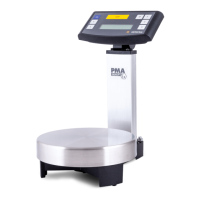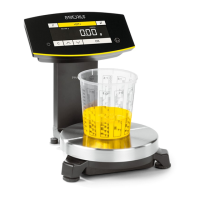16
Adjusting the Overload Stop
Checking the Overload Stop
- Open the balance/scale housing (see page 14).
- Place the weighing pan (101) and, if applicable, the pan support (103)
on the balance/scale.
- Center the maximum load (e.g., PT6-000V1: 6 100 g) on the weighing
pan; contact between the beam and the overload stop (107) must be
avoided.
- Afterwards, gradually increase the load on the weighing pan (in at least 4
equal increments) until it equals the maximum load plus 20% (e.g., PT6-
000V1: 6 100 g + 15% => approx. 7 000 g).
- Keep an eye on the overload stop (107) when loading the weights; only
once the maximum load plus 10% - 15% has been reached (e.g., PT6-
000V1: approx. 6 700 g - 7 000 g) should the beam contact the
overload stop.
If the beam contacts the lower overload stop (107) before the load equals the maximum load plus 10% - 15% or does
not contact the lower overload stop once the load equals the maximum load plus 15 %, the overload stop must be
readjusted.
If the overload stop (107 is in the correct position, you should first check and, if necessary, adjust the zero point offset
value before closing the balance/scale housing (see page 17).
Adjusting the Overload Stop
- Open the balance/scale housing (see page 14).
- Place the weighing pan (101) and, if applicable, the pan support on the
balance/scale.
- Now place the maximum load plus approx. 15% on the weighing pan
(101) (e.g., PT6 000V1: 7 000 g).
- The stop (107.A) of the strain gauge system (106) must now come to rest
on the lower overload stop nut (107).
- If this is not the case, loosen the lock nut (107.B) and carefully turn the
overload stop (107) to this correct position; then retighten the lock nut
(107.B).
- Then check the overload stop (107) again as previously described.
If the overload stop is in the correct position, you should check and, if necessary, adjust the zero point offset value
before closing the balance/scale housing (see page 17).

